
Winter Walking Boot Buying Guide
Posted On: 06th January, 2025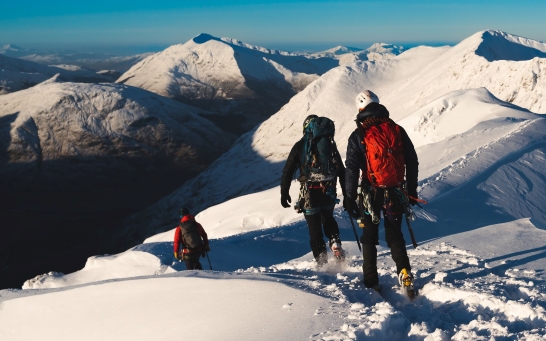
Photo credit: Peak Climbing School
Anyone who’s spent time in an outdoor shop has, probably, one time or another stared at a wall of gear, wondering how on earth to figure out what you need. If you’re looking to arm yourself with the knowledge to make informed decisions or to better understand your options before seeking expert advice, this guide is for you.
Things to think about when buying or renting winter boots
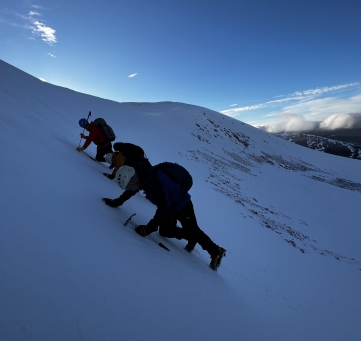
Photo credit: Peak Climbing School
- What terrain are you planning to travel in?
For summer mountaineering or light winter use, you may only need boots stiff enough to kick the side of a slope. On the other end of the spectrum, ice climbing on steep terrain requires a much stiffer boot to support your foot when paired with crampons. This is determined by the boot's B-rating (explained later).
- What conditions and environment will you be travelling in?
For alpine summits, high-altitude trekking, or scenarios where you’re stationary for long periods (like belaying during a climb), a B2 or B3 boot with insulation may be more appropriate. However, for mixed summer and winter walking, where you’ll mostly be on the move, lighter boots without insulation might be better.
- What personal aspirations do you have?
Mountaineering and climbing boots can be a significant investment. Choosing a pair of boots that match your current plans but leave scope for future goals, like exploring more into the mountaineering or climbing world will save you from needing to upgrade later and spending more than you have to.
B-Rating Breakdown: From Walkers to Climbers
Winter boots need to be stiff for stability, to hold a crampon, to allow you to hold an edge and kick steps in steep snow. They also have a deeper tread assisting grip and stability up and down slopes.
There are three main levels of stiffness: B1, B2, and B3. The stiffer the boot, the better it holds an edge, so if you are wearing a B3 boot and standing on the point of your toe on a small hold it almost acts as a platform rather than the pressure being in the arch of your foot.
If you strap a crampon onto a flexible boot, the motion of walking can cause the sole of the boot to fold and the crampon to dislodge, so the stiffness of the boot will be important to match the kind of winter adventure you’re having.
B1 Boots
- Lightweight and flexible, ideal for:
- Summer scrambles
- Gentle glacier crossings and snow plods
- A boot that will cross over with summer and winter mountain days
- Best combined with a C1 crampon for winter hill walking.
- Drawback: Limited insulation and waterproofing, which can be uncomfortable in harsh winter conditions.
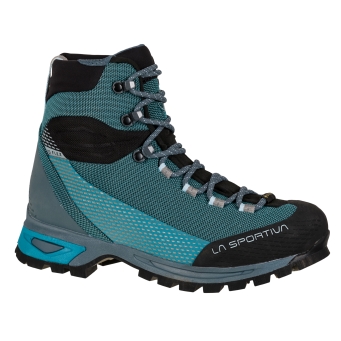
Photo credit: La Sportiva
B2 Boots
- The “all-rounder,” perfect for:
- Scottish winter walking
- Low to mid-grade winter climbing terrain
- Summer scrambling, thanks to excellent edge-holding capability.
- Comfortable to walk in
- Compatible with C1 and C2 crampons.
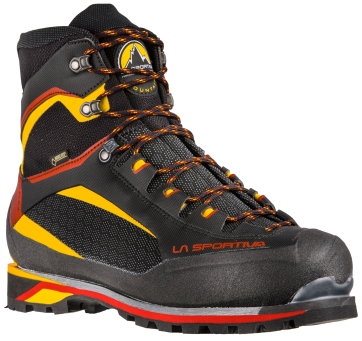
Photo credit: La Sportiva
B3 Boots
- Designed for the toughest conditions:
- Vertical ice climbing, mixed or technical climbing
- High-altitude, cold-weather expeditions
- Offer superior insulation and stiffness for front-pointing and traversing steep terrain.
- Often have front and rear welts to fit in C3 crampons.
- Downside: Less comfortable for general walking or non-technical terrain.
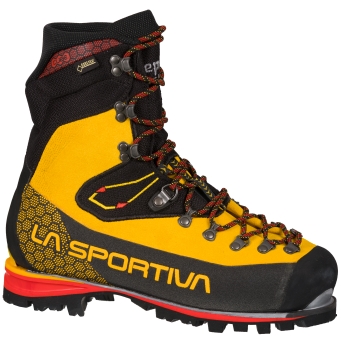
Photo credit: La Sportiva
Matching boots to Crampons
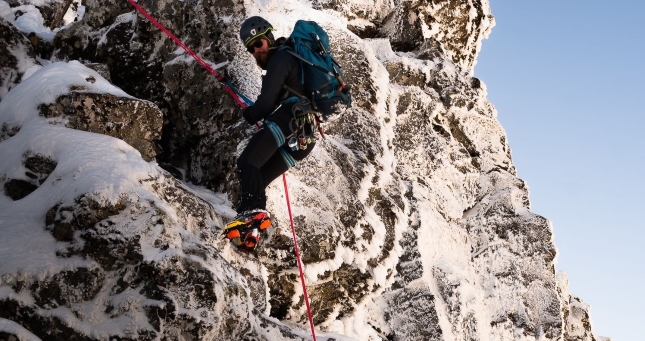
Photo credit: Peak Climbing School
Crampons, like boots, have a stiffness rating. You can fit a softer crampon to a stiffer boot, but not a softer boot to a stiffer crampon. For example, you can fit a C1 or C2 crampon to a B2 boot, but you can't fit a C3 crampon to a B2 boot. There is some variance in crampon models, so it can be worth checking compatability with your boot model.
-
C1: The softest of the crampons and the most comfortable to walk in, most of the points are vertical to allow the crampon to have some float in the snow. They generally feature a basket at the front and rear of the crampon, so have a fairly universal fitting.
- C2: A stiffer crampon, great for bridging the gap from walking to gentle climbing. They have a mix of vertical walking points and horizontal climbing points. They often have a basket at the front and a clip at the rear, this clip only fits on boots with a rear welt (ledge). These are often referred to as semi-automatic crampons.
- C3: The stiffest of the crampons and largely designed for climbing. These crampons have either twin or mono points at the front specifically for climbing vertical terrain. Depending on your objectives for the day will determine whether you choose a twin or mono point (Some models are even changable between the two). C3 crampons are generally a more specialist tool so some deeper research or expert advice may be required to ensure you're getting the right crampons for you. A fully automatic crampons will require a welt at both the front and rear of your boots.
When walking in soft snow it is easy for the snow to build up underneath your crampons making it harder to walk and also potentially preventing your crampon points from digging into the snow surface. The result of this may be a slip or fall with potentially serious consequences. We'd always recommend you use crampons with inbuilt anti-balling plates.
Beat the Cold: How Insulation and Weatherproofing Work
Contrary to popular belief, you don’t always need heavily insulated boots or thick socks for winter mountaineering. In reality if you’re spending a lot of time traveling, the movement of the foot generates a good amount of warmth. It’s common for our winter skills course team to use an uninsulated boot and medium thickness walking sock for courses. If you are expecting some short periods of standing around or conditions are looking particularly cold a thicker sock can be enough, although if you’re prone to really cold feet or prolonged periods of inactivity an insulated boot could be important. Single layer boots are realistically the most common for UK winter.
Single-Layer Boots
- Do not have a removable liner.
- Lightweight and less insulated—perfect for approach walks and Alpine-style mountaineering in warmer conditions.
- More insulated single-layer options exist, but when they get wet, they take a long time to dry.
Double-Layer Boots
- Include a removable insulated liner boot and a waterproof outer shell.
- Offer superior warmth but are bulkier than single-layer boots.
- Easier to dry when wet, and even when damp, they retain insulation better than single-layer boots.
- Often have a boa tightening over standard laces, its worth considering the ease of repair when you’re remote.
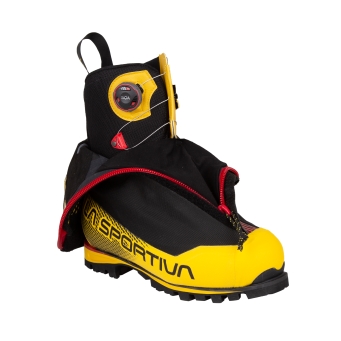
Hybrid/Integrated Gaiter Boots
- Combine the benefits of double-layer boots with an integrated gaiter to seal out snow and water.
- Offer maximum insulation and protection, making them ideal for high-altitude, polar climates, and extreme conditions.
Scottish Winter Ready: Must-Have Boot Features
- Solid and angular boot edge- essential for using the side of the sole to cut steps into snow slopes, when snow is firm but crampons not required.
- Thick rubber or leather toe rand- this protects the toe of boot from impact with snow when kicking steps, plus adds an extra layer of abrasion to protect against wear and rocks when scrambling.
- Full waterproofing: Look for boots made from synthetic materials, leather, or a combination of both.
- Synthetic: Lightweight but less durable.
- Leather: More robust but requires regular care.
- Sealed boot tongue- this prevents snow entering between the tongue and the sides of boots if the boot doesn’t have an inbuilt gaiter although they can be slower to dry as a compramise
Pro Tip: Snow’s pretty dry until it melts. If your boots or hardshell trousers don’t have a gaiter, we’d recommend using a pair of high gaiters over what boot you decide to buy or rent to prevent snow and water entering over the top.
The best boot is the one that fits you.
The reality is different brands fit slightly different, most of our team really get on with the fit of LaSportiva but objectively that doesn’t make them any better than any other reputable brand. Here’s our top tips for getting the best fit
- Determine the features you need, then explore models across reputable brands.
- Visit a well-stocked outdoor shop and try on multiple pairs with the socks you’ll wear in winter.
- Ensure your feet are held firmly in place to prevent:
- Blisters from friction.
- Toe bruising from impacts during downhill walking or snow kicking.
Fit Test: Remove the insole, place your foot on it while seated, and check the toe gap. When standing, your toes should approach but not touch the end. For kicking activities, tighten the boot and simulate a “skid”—your toes shouldn’t hit the front.
Key Takeaways
- Choose boots based on terrain, conditions, and aspirations.
- Understand boot stiffness (B1, B2, B3) and match it with the right crampons (C1, C2, C3).
- Select the right insulation level—single, double, or hybrid.
- Prioritize essential features for wet and snowy conditions.
- Focus on a proper fit to ensure comfort and safety.
Whether you’re winter hill walking, tackling Scottish Munros, or climbing vertical ice, the right pair of boots can make or break your adventure.
Share this Article
Recent Blog Posts


Sintra- Bouldering Destination Guide
Posted: 21st January, 2025 Read Article
What to Pack for a Climbing Course: An Essential Kit List
Posted: 14th January, 2025 Read Article
El Chorro- Sport Climbing Destination Guide
Posted: 12th January, 2025 Read Article
